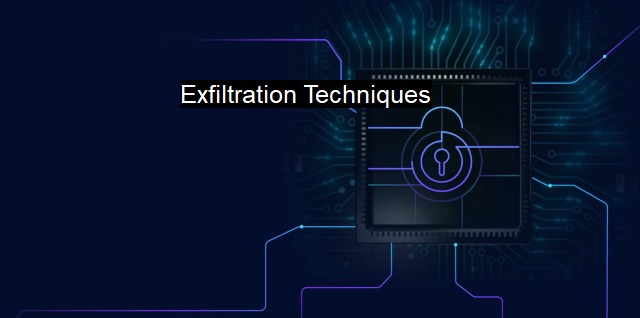What are Exfiltration Techniques?
Mastering Exfiltration Techniques for Strong Cybersecurity: Safeguarding Your Information Systems from Advanced Hackers
"Exfiltration Techniques" hold a pivotal role. Exfiltration Methods refers to strategies or methods used by cyber attackers to transmit unapproved or unauthorized data or information from a system or network. It is also known as "data exfiltration", "data exportation", "data extrusion", or "data theft". The main goal of attackers using these methods is to compromise the system or network, spelled out in the long list of pernicious activities—scanning and prying sensitive information, revealing undisclosed data, robbing financial assets and plant malicious software among others.Exfiltration Techniques broadly pave paths for two major threats. Firstly, it reads and takes out sensitive and private data like financial details, secret information of organizations, or personal subjects. Secondly, it comprises “malware exfiltration,” via which malicious software or malware is entered into the system. It works covertly and the effect is generally seen when the damage has been done. The use of advanced technology and improved knowledge makes it more challenging for traditional cyber defense systems to detect these techniques.
These techniques are usually carried out in stages. Initially, the attacker would infiltrate the network or system. They would then gain access and increase their privileges to disrupt normal functions and operations. Afterwards, they would quarantine any sensitive information or data they could exploit. The final step would involve exfiltrating this data outside the network. This could be transmitted across different channels, physical or virtual, and the command and control (C&C or C2) changes its process, making it seem like normal process system. The exfiltrated data could later be exploited by the attackers for various illegal activities such as identity theft, selling the data on the dark web, or other types of cybersecurity crimes.
Numerous Exfiltration Techniques are established by cyber attackers such as HTTP(S) and DNS Exfiltration. In HTTP(S) Exfiltration, data is camouflaged and transmitted through HTTP or HTTPS traffic operating as service requests or back-and-forth responses. On the other hand, DNS Exfiltration utilizes the DNS request and response system to transmit the data steadily yet dodging detection.
Advanced and sophisticated exfiltration techniques possess certain key characteristics. The techniques are generally versatile and multi-purpose, capable of gaining access to a host of systems. Often these techniques are designed for easy reconfiguration and modification, enabling cybercriminals to adjust their exfiltration plans based on the security measures in place. Meanwhile, some advanced exfiltration techniques are specifically constructed to privately conduct lateral movement across a network, sneakily exfiltrating fake data while leaving the real data untouched to provide a decoy illusion.
Exfiltration Techniques are far from benign and unchecked, can have dire consequences on the victims. In response, preemptive security measures like firewall configuration, egress and ingress filtering, and ‘deny all’ rule for outbound traffic are delivered to get them combat-ready and fend off cyber menaces. Anomaly behaviors detection tools are actively utilized as well. Frequent training of staff, regular system analysis and employing methods such as penetration testing and threat modeling can also be essential factors in fortifying against these grave cyber threats.
Understanding Exfiltration Techniques is indistinguishably connected to maintaining cybersecurity. In the fight against constant evolving cyber threats, staying informed of the most recent advances in exfiltration techniques is of paramount importance. it is crucial that we be cognizant of the white-hat counterparts aimed at detecting and defending against such hazards to preserve the well-being and security of our digital landscape. This-call-to-action is the epitome of digital economy survival in the 21st century.

Exfiltration Techniques FAQs
What are exfiltration techniques in cybersecurity?
Exfiltration techniques in cybersecurity refer to the methods used by attackers to steal or extract sensitive data from a company's network or system. This can include techniques like data exfiltration, data theft, and data leakage.What are some common exfiltration techniques used by attackers?
Some common exfiltration techniques used by attackers include data exfiltration via file transfer protocols, DNS exfiltration, steganography, and tunneling.How can antivirus software help prevent exfiltration attacks?
Antivirus software can help prevent exfiltration attacks by detecting and blocking malware that may be used for exfiltration, monitoring network traffic for suspicious activities, and implementing access control policies to stop unauthorized data transfers.What are some ways that companies can protect themselves from exfiltration attacks?
Companies can protect themselves from exfiltration attacks by implementing strong access controls, monitoring network traffic for suspicious activities, encrypting sensitive data, and regularly patching and updating software to address vulnerabilities. Additionally, companies can conduct security audits and employee training to increase awareness of potential exfiltration threats.| | A | | | B | | | C | | | D | | | E | | | F | | | G | | | H | | | I | | | J | | | K | | | L | | | M | |
| | N | | | O | | | P | | | Q | | | R | | | S | | | T | | | U | | | V | | | W | | | X | | | Y | | | Z | |
| | 1 | | | 2 | | | 3 | | | 4 | | | 7 | | | 8 | | |||||||